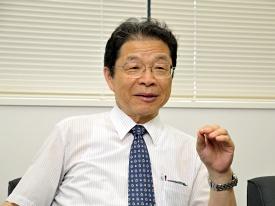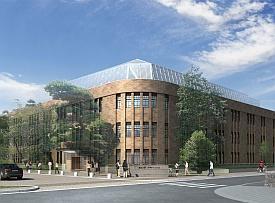

10/25/2010

The WPI-AIMR first opened its doors in 2007 as one of the first of five World Premier International research centers to be created under a new initiative of the Ministry of Education, Culture, Sports, Science and Technology of Japan and administered by the Japan Society for the Promotion of Science. The WPI-AIMR has successfully navigated its first three years of life. Now, having established itself as a leading center of materials research in Japan and with a growing international reputation, attention within the WPI-AIMR is turning to the next phase of development. AIMResearch talked to the institute’s director, Yoshinori Yamamoto, an internationally renowned chemist, about the successes and challenges of his three years at the helm and the path that he has laid out for the future direction of the institute.
AIMResearch: The WPI-AIMR has a broad and interdisciplinary remit. What do you think stand out as the institute’s biggest achievements to date?
The WPI-AIMR program has two main objectives: one is to develop new innovative materials through the fusion of research, and the other is to establish a new management system that best suits WPI-AIMR. However, achieving these objectives is not so easy.
We have research groups working in bulk metallic glasses, materials physics, soft materials and devices/systems and all of them have made great progress over the last three years. In bulk metallic glasses, for instance, we have published a paper about the controlled formation of metallic glass nanowires in Advanced Materials1. Nanowires are useful materials for a wide range of applications and we were the first to make metallic glass nanowires. In materials physics, we have published a paper concerning the mechanism behind superconductivity in Europhysics Letters2. We have the most powerful angle-resolved photoemission spectrometer in the world and we used it to show that electron spin plays an important role in superconductivity. The paper has so far received more than 300 citations. In soft materials, we are making nanoporous palladium catalysts. In devices/systems, we are investigating the use of bulk metallic glasses as soldering materials in microelectromechanical systems.
AIMResearch: Setting up the center and guiding it through its initial phase could not have been easy. What were some of the challenges and how did you overcome them?
Asking researchers to jump outside their own research discipline was quite a challenge. On the one hand, senior researchers prefer to stay in the same discipline especially when they have established a presence in the community. On the other hand, young researchers want to establish their own discipline before they venture into something new. I think a good researcher should have a wide view of science, no matter how challenging it may be. At the WPI-AIMR, I often see young researchers jumping between laboratories. There is extensive collaboration going on and I think this is a very good thing. However, the fusion of research is much bigger than just collaboration. I hope that in the near future, our researchers will go beyond collaboration and create some entirely new science.
Reforming our management system was another challenge. Most principal investigators in Japan believe in equality — everyone should get the same area of space, hire the same number of researchers and receive the same salary. Here at the WPI-AIMR, everything depends on achievement. If your results are excellent, you can hire more people and get more space. Such a management model is very rare in Japan, but I think it suits the WPI-AIMR very well.
AIMResearch: A key part of the WPI Initiative is the globalization of research. What plans do you have for strengthening international collaboration?
Internationally, we have been collaborating with the University of Cambridge in the UK in bulk metallic glass research. We have also started collaborating with the Institute of Chemistry, Chinese Academy of Sciences (ICCAS) in materials research. The WPI-AIMR is strong in materials physics, while the ICCAS is strong in materials chemistry. I think this collaboration will benefit us both.
AIMResearch: Earlier this year the WPI-AIMR was evaluated by a follow-up committee to assess the progress of the project. What were their key findings and advice?
Every year, we need to report the progress of the WPI-AIMR program to a follow-up committee. This year, the program director and members of the working group of the follow-up committee carried out a two-day site visit at the WPI-AIMR. They submitted a very detailed report to upper committee members from Europe, the United States and Japan. In July, we had a meeting with the upper committee members in Tokyo. We gave a 15-minute presentation and the upper committee members posed some very serious questions and gave some valuable advice. For example, they said that our quality of science is excellent. However, they also said that there is room for improvement in promoting the fusion of research and global visibility.

AIMResearch: The WPI-AIMR will enter its second phase in 2012. What plans does the WPI-AIMR have for the future?
We have set a roadmap for the WPI-AIMR program. In April next year, the construction of the WPI-AIMR main building will be completed. Then in October, we will have an interim evaluation. This is a very important time as we will re-evaluate the directorship, the principal investigators and all researchers, and make any changes that may be necessary. We will also focus our research on the development of innovative materials, as we have mentioned in our mission statement. In 2017, the WPI-AIMR will enter its third phase. By then, the university must establish a new organization based on innovative materials discovered through the WPI-AIMR program.
AIMResearch: How will the WPI-AIMR’s new building, to be completed in April 2011, help with the research program?
Right now, some of our researchers are working in Aobayama campus. They will all move to the new building at Katahira campus once the new building is ready. To do fusion research, the researchers must stay in the same building. The building is sort of like a beaker, and my job is to shake things up.